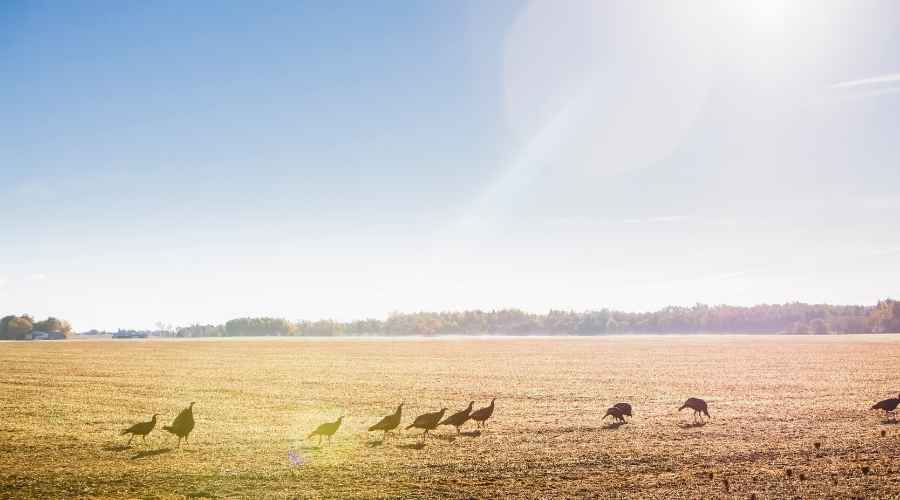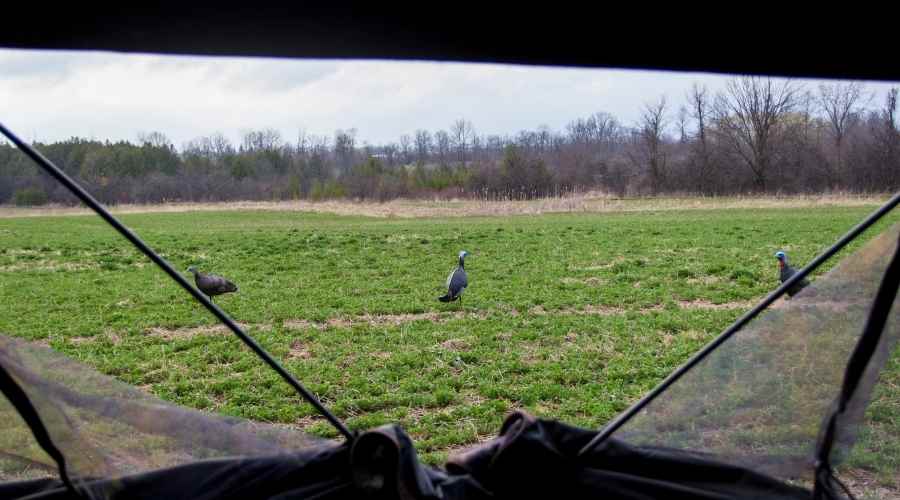With turkey season just around the corner in most states, many avid bowhunters have begun preparing for what lies ahead. For most archers, this involves preparing all necessary equipment and diving headlong into a strategic scouting routine.
However, far fewer archers recognize the value of diligent pre-turkey season practice.
When turkey hunting, shot opportunities can be rather unpredictable and often test even the most proficient archer’s abilities.
TL;DR
Practice sitting shots: Most turkey shots are from a sitting or crouching position. Practice these body mechanics to improve your accuracy.
Practice from a blind: If you hunt from a ground blind, practice shooting from within it to familiarize yourself with its limitations and angles.
Practice at various distances: Turkeys can appear at any range, from close to far. Practice shooting from 10 to 40 yards to maximize your efficiency.
Practice on small targets: Turkeys have small vitals and require precise shots. Practice aiming at a specific spot on a foam or 3D target to simulate a turkey’s anatomy.
Contents (Jump to Topic)
ToggleYou can overcome many such difficulties by adhering to several pursuit-specific practice exercises. These exercises will assist you in making the most out of each available shot opportunity this spring turkey season.
Practice Sitting Down
While most archers practice while standing upright, one is seldom presented with shot opportunities of this nature when turkey hunting.
On the contrary, most shots during the spring turkey season are from a sitting or crouching position. This stems from the fact that a hunter must remain concealed, with little in the way of excess movement, when attempting to execute their shot.
However, shots of this nature can prove difficult when not practiced regularly. In order to overcome this obstacle, you can add shots of this nature to your practice repertoire.
This will allow you to familiarize yourself with such shots’ body mechanics, leading to increased accuracy when faced with a similar situation while afield.
Shoot From Your Blind
Many turkey hunters now hunt from a ground blind, rather than from a seated position while naturally concealed.
While this has proven to be a highly effective tactic, hunting from a blind does present its own distinct challenges for the avid bowhunter.
At times, shooting from within a blind can prove much more difficult than you might initially think, especially if you have not previously practiced in this manner.
This fact highlights the importance of practicing your marksmanship, while seated within a blind, in advance of opening day.
It is also ideal to practice from the exact blind that you intend to hunt from, if at all possible. This allows you to familiarize yourself with any limitations faced when afield, such as being forced to shoot through narrow openings and at various angles.
Practice At Various Distances
When turkey hunting, you never know when, where, or at what distance a shot opportunity will present itself.
In some cases, a turkey will commit to a decoy or a hunter’s calling, providing you with a shot at close range. In other cases, however, a wary bird will flank your position, making a shot of a longer distance necessary.
In any event, you should be prepared for whatever unfolds.
This places extreme value on practicing at various distances in preparation for opening day. Ideally, you should practice repetitively at distances of ten to forty yards to maximize your efficiency in almost every scenario.
As mentioned above, it is also important to practice at these ranges while sitting, kneeling, and crouching, as this accurately represents that which can be expected while afield.
Prepare For Your Anticipated Target
When shooting at a turkey with an archery tackle, little margin for error is presented. Most turkeys are shot in the vitals, which are rather small in size.
Alternatively, some archers choose to aim for the head and neck region. No matter the case, the slightest deviation of an arrow’s flight can lead to a missed opportunity.
Therefore, preseason practice should be conducted by shooting at targets of a similar size to that of a wild turkey.
In many cases, a standard-size foam target can be used for this purpose. When doing so, attempt to aim at a particular spot on this target to replicate the challenges associated with striking a turkey’s vitals.
For those that wish to go the extra mile, proportionally correct 3D turkey targets can be purchased for a reasonable fee. The use of these targets makes it possible to recreate scenarios faced while afield, to a high degree of accuracy.
Know Your Broadheads
Turkey hunting can be conducted with various broadheads (read.. turkey hunting broadheads), which often differ significantly in style and design. As such, each of these individual broadheads flies in its own unique manner.
Understanding a broadhead’s flight characteristics can quite often serve as the difference between a lethal hit, and a heartbreaking miss.
This principle is most easily observed when patterning a particular broadhead.
While it is not advisable to shoot a broadhead before season, that is intended for use in a hunting scenario, it can be quite helpful to shoot additional broadheads of the same make to evaluate their performance.
Alternatively, many packs of broadheads included a practice head of a similar design, that can be used for a similar purpose. No matter the method is chosen, an afternoon spent patterning broadhead can prove to be of substantial value.
Practice Makes Perfect
In the world of archery, practice really does make perfect. This fact rings just as true when bowhunting, as it does when competing in formal competition.
However, ample preseason practice is paramount for those wishing to punch their spring turkey tag.
The American wild turkey is extremely wary and poses a unique challenge for even the most seasoned archers.
Implementing the above-mentioned exercises into your existing practice regimen will give you the best chance at capitalizing on any available shot opportunity this spring.
This, in turn, significantly increases one’s chance of success in the months to come. This season, avoid the pitfalls of complacency by varying your preseason practice routine to take your bowhunting prowess to the next level.







